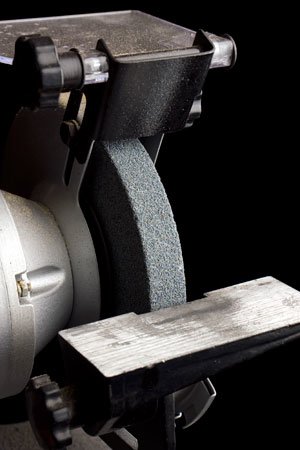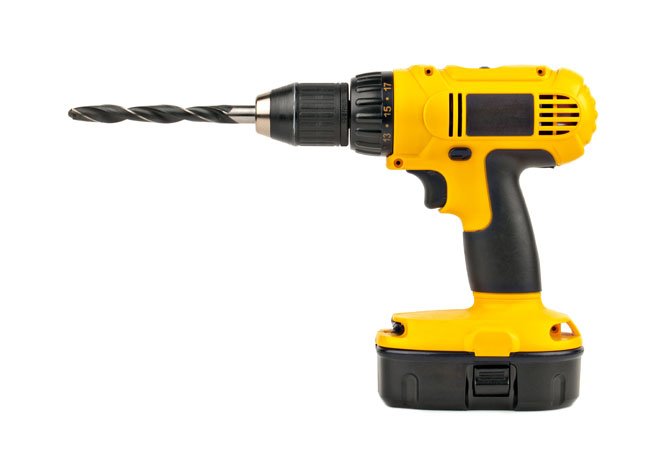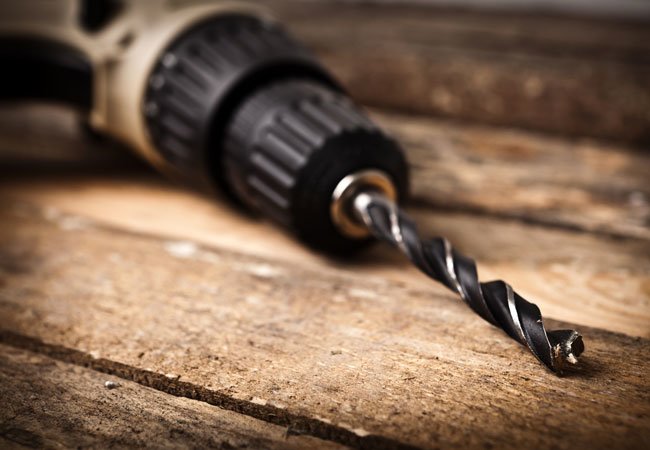We may earn revenue from the products available on this page and participate in affiliate programs. Learn More ›
Do-it-yourselfers live by the rule of “the right tool for the job,” but just as important is maintaining those tools so that they can do their jobs. Case in point: Keeping twist drill bits sharp. When bits get dull, your natural inclination is to push the drill harder, which inevitably causes bits to break and could even result in personal injury. Though there are gadgets specifically designed to put a precision point on drill bits, the bench grinder in your workroom may be all you really need. Pointed drill bits make safe, easy work of many projects, so—while it takes a bit of practice to hone them like a pro—there’s no better time to learn how to sharpen drill bits than before your next task.
MATERIALS AND TOOLS
– Bench grinder
– Safety goggles
– Work gloves (optional)
Note: Some find that wearing work gloves impairs the ability to get a safe grip on a drill bit. Because it’s crucial to have a firm hold on the bit while grinding, gloves are listed as optional. Safety goggles, however, are a must.
How to Sharpen Drill Bits
STEP 1
Examine your dull bits. Your goal is to remove only enough metal to get a sharpened edge. Many bench grinders have two grinding wheels, one coarse one and one fine. If the bits are really ravaged, start with the coarse wheel, and switch to the finer one later in the process; if your bits don’t look too bad, begin with the finer grinding wheel.
STEP 2
Don your goggles and turn on the bench grinder. Get a firm grip on your drill bit and hold the cutting edge precisely parallel to the front of the grinding wheel. Slowly, carefully, move the bit until it contacts the wheel. Do not turn or rotate it; simply keep it straight and held at the original factory angle of 60 degrees.

STEP 3
Hold the bit at this angle against the wheel for no more than four to five seconds. Remember: Your objective is to simply grind the dull surface away, not wear down the bit. Focus on grinding the heel of the bit, where the tip meets the twisted shaft—not the edge—to achieve the ideal angle. If the angle isn’t steep enough, the drill bit won’t bore smoothly.
STEP 4
Pause after four to five seconds of grinding and dip the drill bit into the ice water to cool the metal. Failure to do so will cause the drill bit will become too hot to hold and even wear down the metal faster, shortening the effective life of the bit. Once the bit is cool to the touch, inspect it to see if it’s honed to a good point on the side you just worked.
STEP 5
When satisfied with the point on the first side, turn the drill bit 180 degrees and use the same grind-and-cool process for the opposite side of the tip. Aim for that 60-degree angle, and an angle and point that’s the same width on both sides of the drill bit, to enable the tool to bore straight holes. To help ensure equal sharpening, some people opt to sharpen a little on each side, holding the drill bit in their dominant hand and flipping it 180-degrees after every few seconds of grinding.
STEP 6
Once the drill tip meets in a finely honed point, and both edges are sharp and the same width, give the bit a test run. Hold the tip perpendicular against a piece of scrap wood and twist the bit by hand. Even with this light pressure, a well-sharpened drill bit should create the beginnings of a hole. If not, re-examine your tip and return to the grinding wheel. Again, strive for that ideal 60-degree slope on the point, with equal widths on either side. Don’t be disheartened if you return to the wheel several times—that’s part of the learning curve.
STEP 7
Once you’re confident in the sharpness of the bit, insert it in your drill, grab that scrap wood, and begin drilling. It should “bite” the wood right away with minimal pressure and, when you extract the drill bit from the wood, it should fling wood chips as it emerges.

Top Tips for Keeping Drill Bits Sharp
Once you’ve successfully mastered how to sharpen drill bits, maintain a cutting edge with these three best practices.
- For every inch or so that you drill, pull out the bit and blow off any flakes or chips of wood. Otherwise, these chips will get packed into the flutes of the bit, becoming very hot. The hotter a drill bit gets, the faster it dulls, requiring more frequent sharpening.
- Make the stop-and-cool technique a habit, especially when drilling hardwood. Simply keep a container of cold water nearby and dip the drill for a several seconds between every few inches of drilling.
- Keep two complete sets of drill bits. Some pros rely on a like-new set of drill bits only to start a hole, and then—to keep that better set sharper for longer—switch to their older, sharpened bits to finish the task once the drill hole has been established.

